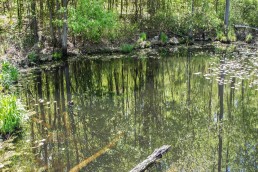Catching Shadowline Bass
SHARE THIS POST
Bruce Litton throws to bass on the shadowline for big summer catches.
The “magic hour” early and late in the day isn’t the only time to catch summer largemouths. They eat all day. Higher water temperature means their metabolism burns more calories, so they fill that inner demand. It’s a matter of what they feed on, and how, instead of whether they’re feeding at all under that scorching sun.
During the day, bass take whatever easy meal drops their way. Maybe a tadpole, a grasshopper or a leech. Bass even feed on nematodes and subaquatic insect larva. Bass are alert in warm water, often waiting in shadowy nooks to punch forward and engulf their prey.
Bass eyesight is advantaged in dim light. They easily see prey illuminated beyond the shadowline, between relative darkness and sun-struck water. But, any forage fish a bass sees might get a pass. Forage fish tend to be skittish and on the move during daylight hours. A bass would burn calories it needs to conserve by making chase. A plastic worm, however, represents an easy pick for the bass. Besides, larger worms about eight inches long seem like worthy meals to them, filling that need for calories.
‘Traditional’ worms
I’ve caught plenty of bass at high noon with temperatures in the middle 90s by fishing the edges between shadow and sunlight, pitching and casting unweighted plastic worms. Instead of using worms with frills like twister tails, I stick to a traditional style. They don’t even have fluted tails. By mounting them on 2/0 worm hooks, tying a fluorocarbon leader directly to 15-pound-test braid by uni-to-uni splice, even 8-inch worms work well on these hooks. I want as little weight as possible carrying that worm to bottom. When I’m fishing shadowlines with no cover or heavy weeds in the water, I just go with a plain-shank, size-2 hook. It’s sufficient without burying the point in plastic.
Uncovering bass in cover
Despite my predilection for finding bass where they wait in ambush position underneath something, inches beyond the line between sunlit water and shade, the target zone is more important than cover. In some situations, there just isn’t any of that. Shade itself is enough.
Are you enjoying this post?
You can be among the first to get the latest info on where to go, what to use and how to use it!
The depth I fish typically ranges from 2 to 12 feet. Even though August can get especially tough in the middle of the day, afternoon catches do happen in spots on the shallow side by applying persistent effort. If the bass are good size, as often is the case in waters that fish on the slow side, I feel it’s worth the effort in the heat.
Be accurate, be patient
Fishing an unweighted worm involves an art of casting accuracy to hit a target space cleanly, and patience to let it sink slowly. You can’t cover water quickly—as you would with a swimming plug or spinnerbait—but, when you go get a worm in front of a bass, chances are good the fish will ease in on it and flex its jaws. Don’t complete a slow retrieve every time you cast. Often, all you need is the initial drop. If no bass takes the worm, quickly retrieve and cast to another likely spot.
I catch summer largemouths on Senkos, but I only use them when I think bass may be more aggressive. Senkos happen to be especially effective, instead, on smallmouths because they sink faster. Since smallmouths are more aggressive than largemouths, they’re more likely to take a faster-moving bait.
Whichever you choose, pitch or cast to the sunlit side of the shadowline. Any bass in the shade sees, in high definition, a tantalizingly slow-sinking treat. You can catch plenty if you don’t care to fish before breakfast or after dinner.
Get more facts about bass in the July issue of MidWest Outdoors, available the first full week of July at the newsstand or by subscribing on our website.
MWO
SHARE THIS POST
You may also like...
Nothing found.
Did you enjoy this post?
You can be among the first to get the latest info on where to go, what to use and how to use it!
Bruce Edward Litton
MidWest Outdoors works with more than 200 outdoor experts each year, who contribute articles based on their areas of expertise. MidWest Outdoors magazine offers more fishing and hunting articles than any other publication!
